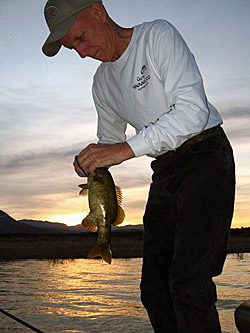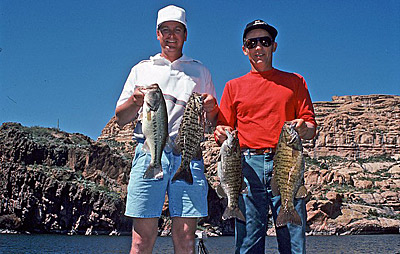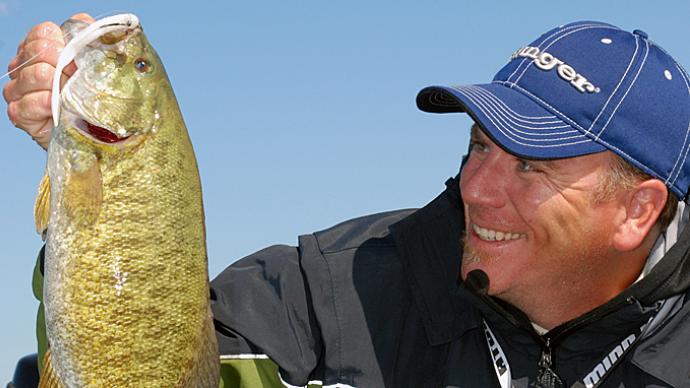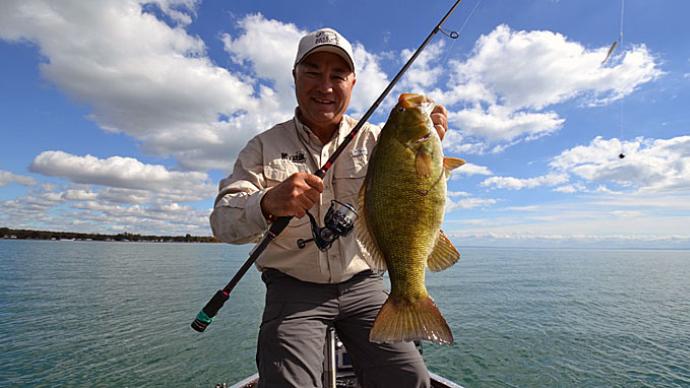
Smallmouth bass are not as numerous as largemouth bass in most of our lakes, so they can seem harder to pattern and catch. They’re also smaller than largemouth – the world record is an 11-pound, 15-ounce smallie caught by David L. Hayes at Dale Hollow Lake in 1955. That record is just about half what the world record largemouth weighed. That one was caught in 1932 by George Perry and weighed in at a whopping 22 pounds 4 ounces. Because of their smaller numbers, catching a smallmouth bass can seem like an accident, but you can indeed target smallies.
Where To Fish
Chunk rock (volleyball size) makes great smallmouth territory because it holds crawfish. Arizona’s Apache Lake has always been known for quality smallmouth fishing, and some of the most successful smallmouth fishermen look for banks with big rocks and throw live crawdads. One guy says they have to be 1-inch crawdads – if it’s two inches, they won’t bite. This same guy says that steeper banks are the best. You don’t necessarily need to target points or coves, just steep rocky banks. You’ll need to keep the boat close to shore on the steep banks to keep your lure in the strike zone.
Occasionally you’ll get into a bunch of smallmouth bass on a rocky reef or a big rock pile. They also seem to bite better in bad weather. To know more about smallmouth bass, you need to learn about crawdads. Crawdads eat just about anything, including decaying vegetation, snails, fish, dead animals, worms, algae, and even other crawdads that are molting. Anyplace where something can sink into, and decay will attract them. That’s why big rocks are so great – lots of nooks and crannies hold all kinds of stuff that sinks to the bottom after death.
Study the crawdads in your neck of the woods. When do they molt? What do they eat? When do they move most, and where do they live? This will help you find the smallmouth.
Smallmouth are more territorial than largemouth bass, and the bigger ones usually have an area they hang out in, but in that area, they will cruise around most of the time looking for food. The spread of quagga mussels and zebra mussels has made clear water reservoirs even more clear, with the result that the smallmouth bass is often staying even deeper than they did before. They also spawn deeper and in cooler water than largemouth bass.
Lures To Attract Smallmouth Bass
Besides split-shotting live crawdads and worms, you can also catch smallmouth on artificial lures. Most of the guys I talked to about smallmouth bass suggest downsizing your regular largemouth lures. Try smaller spinnerbaits and even inline spinners. Panther Martins are a killer smallmouth bait on Apache Lake. Reel them fast, even in winter, and pop them now and then so they look like wounded baitfish. Chartreuse spinnerbaits are dynamite during pre-spawn, roughly when the water temperature rises from the ’40s to 50s. On spinnerbaits, the smallmouth bite often feels like your line’s been cut.

A swim jig is another great pre- and post-spawn bait for smallmouth when they are often suspended off those rocky structures they like. Swim jigs can be even better than crankbaits because you can fish them at any depth. Swim them down little channels – cast it out, let it hit bottom, then crank it so it kisses off rocks and other cover. Crank steadily and choose a good jig pole with 17- to 20-pound-test mono. If there are a lot of zebra or quagga mussels in your lake, you might be better off with a fluorocarbon line because those mussels can be pretty sharp.
This time of year (pre- and post-spawn), you’ll want to target creek channels, humps, edges of flats, and channels on flats – in other words, near good spawning areas. Watch your line when you make a cast with the swim jig because they often take it on the fall. If they take it swimming, though, they usually hammer it. This swim jig is a dynamite smallmouth bait any time of year – fish it down those steep banks to any depth you like.
A guide once told me that prespawn is his absolute favorite time to guide on Apache Lake. The fish generally spawn in late February here, and the spawn makes them predictable. They will be near those gravel flats or shallow coves, especially the places that warm up faster. He likes a suspending Rogue this time of year – clown color. He doesn’t move it very fast; every time he pulls it, it gives off a great flash. You don’t have to get out there at dawn – the best bite is usually later in the morning. He also slow rolls spinnerbaits down the points during prespawn. A good point will hold fish all day long, and you can often catch several good smallies.
With a jerkbait, the wind is critical. They need to see the flash, but a bit of wind on the surface keeps them from getting too good a look at it. Smallmouth are infamous for following a bait, then turning away. So if there’s any breeze, throw a clown Rogue and work it slow – give it a couple of pops, let it sit for 10 seconds, then give it a couple more. If it’s calm, work it faster, so they don’t get a good look at it.
When smallmouth feed on flats, crankbaits can be dynamite, especially crawdad patterns. I’ve always loved the #5 Fat Rap, and if you still have any old ones, take good care of them! Crawdad Wiggle Warts are great, too – they move a lot of water. Let them rake the bottom and stop them on the boulders. The smallmouth smash it on the stops.
When the smallmouth are inactive, try casting inline spinners on steep banks and cliffs. Cast them parallel to the bank and let them tumble down to the ledges. Keep it spinning and moving, bumping into things. You can also fish little grubs on swim heads or even pea heads. Use 4- to 6-pound test and ultralight gear. Warning – I was doing this at Roosevelt Lake in Arizona, crappie fishing, with an 1/8-ounce pea head and a tiny chartreuse Power Grub. It was spawning season for crappie, and I was fishing right up near shore when the biggest smallmouth I’ve ever had on bit me. I was fishing 4-pound-test. I got too excited when she got close and broke her off. Catching big smallies on light line is an incredible rush and challenging.
Don’t forget to try topwater baits. John Murray says you can start throwing small Spooks and Tiny Torpedos in water temps as low as 50 degrees. Work them over long points close to deep water. Use light line and twitch the baits slowly. These are best over rocky points and banks, he says. Murray also recommends small (3/16- or ¼-ounce) spoons when you can see schools of baitfish on your graph.
Final Tips
A good smallmouth lake will have plenty of deep water, and the current is a plus. Hard bottoms with plenty of rock are ideal. Crawdads will make up over half of their diet when available, so keep that in mind when choosing lure color. If you can catch some craws and see their color, that will help you.
Smallmouth bass have been described as the “gamest fish there is.” I’ve got to agree with that statement. Here in Arizona, we have them in many of our lakes and rivers, and almost everyone I know gets more excited about catching a smallmouth than a largemouth. Legend has it that they were initially stocked in our lakes via rawhide bags on the backs of burros. Everybody loves to catch a smallmouth, and hopefully, these tips from Arizona fishermen will help you do that.




